President of the Naval War College
The president of the Naval War College is a flag officer in the United States Navy. The President's House in Newport, Rhode Island is his official residence.

_001.jpg)
The office of the president was created along with the Naval War College as a whole by U.S. Navy General Order 325, signed by Secretary of the Navy William E. Chandler on 6 October 1884. The order stipulated that a commissioned officer of the Navy no lower in grade than commander be in charge of the college and that that officer's title be "president." It also directed that the president be presiding officer of a board consisting of the president and all of the college's faculty and responsible for determining the professional course of study for students at the college.[1]
General Order 325 identified the college's first president as Commodore Stephen B. Luce, who took office on the day Chandler signed the order.[1] The last captain to serve as president left the position in 1913, after which all presidents have been flag officers. Since 1948, all presidents of the Naval War College have been vice admirals or rear admirals.[2]
While college activities were suspended during the Spanish–American War, the presidency was vacant. When activities were again suspended during World War I, and during periods since World War I between the departure of an outgoing president and the arrival of a successor, acting presidents have administered the college until a new president reported for duty.[2]
The college counts individuals who serve more than once as president as a separate president for each tour for purposes of chronological numbering of the presidents. Acting presidents are not counted.[2]
The presidency of the Naval War College is one of only four positions in the United States Navy which has an official portrait associated with it, the others being the secretary of the Navy, the chief of naval operations, and the superintendent of the United States Naval Academy. The Naval War College Museum holds in its collection the official portraits of all but ten of the presidents, including all presidents since 1939.[3]
Presidents
Presidents of the Naval War College in chronological order.[4]
| Rank | Name | Photo | Term Began | Team ended | Highlights of Term | |
|---|---|---|---|---|---|---|
| 1 | Rear Admiral | Stephen Luce |  |
6 October 1884 | 22 June 1886 | Founder of and driving force behind the Naval War College; "Intellectual Leader of the 'New Steel Navy'"; saw the college as the highest level of professional naval education and "place of original research on war ... statesmanship connected with war, or the prevention of war." |
| 2 | Captain | Alfred Thayer Mahan | 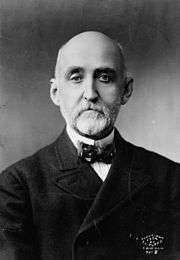 |
22 June 1886 | 12 January 1889 | First of two terms as president. His 1886 and 1887 lectures at the college formed the basis of his internationally influential 1890 naval strategy book The Influence of Sea Power Upon History: 1660–1783. |
| 3 | Captain | Caspar F. Goodrich |  |
12 January 1889 | 22 July 1892 | First of two terms as college president. Oversaw the construction of the college's first purpose-built building, Luce Hall. |
| 4 | Captain | Alfred Thayer Mahan |  |
22 July 1892 | 10 May 1893 | The first person to serve a second term as college president. His 1892 lectures at the college formed the basis of his two-volume 1892 naval strategy book The Influence of Sea Power Upon the French Revolution and Empire: 1793–1812. |
| 5 | Commander | Charles Herbert Stockton | 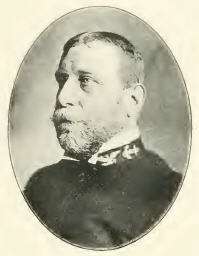 |
10 May 1893 | 13 November 1893 | First of two terms as college president. Although the Department of the Navy authorized no course at the college in 1893, he and the college′s other two staff members prepared one anyway. Discussed the possible closure of the college with Bowman H. McCalla, who in turn wrote to Lieutenant Benjamin H, Buckingham, the commanding officer of the gunboat USS Dolphin, which was scheduled to transport Secretary of the Navy Hilary A. Herbert to Newport in August 1893. Herbert planned to close the college during the visit, but changed his mind after Buckingham gave him Mahan′s The Influence of Sea Power Upon the French Revolution and Empire: 1793–1812 to read.[5] |
| 6 | Captain | Henry Clay Taylor | .jpg) |
15 November 1893 | 31 December 1896 | Established the curriculum the college would use until 1919; made wargaming part of the curriculum and established the use of case studies in studying international law. |
| 7 | Captain | Caspar F. Goodrich |  |
31 December 1896 | 23 April 1898 | Second of two terms as college president. Led the college's advocacy of advanced rational contingency planning. |
| – | – | – | – | 22 March 1898 | 2 November 1898 | Naval War College activities suspended during the Spanish–American War. |
| 8 | Captain | Charles Herbert Stockton |  |
2 November 1898 | 25 October 1900 | Second of two terms as college president. Defended the college against attempts to sabotage it by collocating it with the United States Naval Academy in Annapolis, Maryland.[6] Argued against Bureau of Navigation insistence that it had no officers to detail to the college for the 1899 course, responding that "There is no more important duty on shore, except the absolutely essential professional administrative work, than the study of naval warfare,"[7] and circumvented the Bureau′s opposition by arranging with the commander of the North Atlantic Squadron, Rear Admiral William T. Sampson, for Sampson′s ships to spend the summer of 1899 anchored off Newport while their officers took the course.[7] |
| 9 | Rear Admiral | French Ensor Chadwick | .jpg) |
25 October 1900 | 16 November 1903 | Oversaw the 1901 introduction of battle problems to be wargamed and studied as part of the curriculum[8] and the 1901 publication of the first Naval War College "blue book" on international law.[9] Became first occupant of the President's House in June 1903. |
| 10 | Captain | Charles S. Sperry | 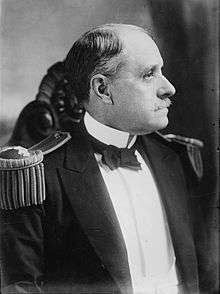 |
16 November 1903 | 24 May 1906 | Developed an extensive knowledge of international law. To emphasize the professional character of the college rather than its function as a school, ordered in 1904 that when describing the college′s academic activities, the words "course" and "class" were to be dropped and the term "conference" was to be used instead.[10] Oversaw the opening of the college′s new library (now Mahan Hall) in 1904 and the appointment of the college′s first librarian in 1905.[11] |
| 11 | Rear Admiral | John Porter Merrell | 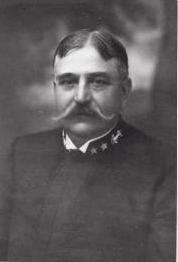 |
24 May 1906 | 6 October 1909 | 1908 summer course suspended by direction of President Theodore Roosevelt on 8 July 1908 so that the General Board of the United States Navy, the bureau chiefs of the United States Department of the Navy, and the college's staff and students could participate in a "Battleship Conference" at the college, with Roosevelt himself visiting to chair the conference for a day on 22 July 1908. Otherwise, Merrell chaired the conference. Secretary of the Navy Victor H. Metcalf closed the conference on 1 September 1908.[12][13] |
| 12 | Rear Admiral | Raymond Perry Rodgers |  |
6 October 1909 | 20 November 1911 | Acting on a suggestion by Captain William Ledyard Rodgers – who had learned it at the United States Army War College – Raymond P. Rodgers introduced the "applicatory system" or "estimate of the situation" into Navy war planning, requiring that planning be developed through a four-step process involving "statement of mission, assessment of enemy forces and intentions, assessment of own forces, and evaluation of possible courses of action."[14] The first edition of the college pamphlet Estimate of the Situation published under his direction in 1910 to teach the applicatory system to students.[15] Established a 16-month "long course" to complement the four-month summer course at the college and allow sufficient time for in-depth study.[16] Tended to favor more cautious approaches in planning for war with Japan. In 1911, Secretary of the Navy George von Lengerke Meyer removed war planning functions from the college, placing all planning responsibilities in the more aggressive General Board of the United States Navy.[17] |
| 13 | Captain | William Ledyard Rodgers |  |
20 November 1911 | 15 December 1913 | Described the goal of his presidency as to broaden "the scope of the work to include studies of national policy as the foundation for laying out naval plans of expansion and also of logistics, organization, and administration of navies as the basis of strategy and tactics of battle."[18] Second edition of the college pamphlet Estimate of the Situation published under his direction in 1911–1912.[15] In 1913, instituted a three-course plan of instruction, consisting of a two-week elementary course, followed by a four-month preparatory course and then the long course instituted by Raymond P Rodgers but renamed the "War College Course."[19] Introduced an option of taking the elementary course as a correspondence course to ease the detailing of officers to the college.[20] Under his presidency, the college issued its first diplomas in 1913.[19] Last non-flag officer to serve as college president, and the only president after 1906 who was not provided with the use of the President's House for his living quarters.[21] |
| 14 | Rear Admiral | Austin Melvin Knight | 15 December 1913 | 16 February 1917 | Oversaw the abolition of the elementary and preparatory courses and the replacement of the 16-month "long course" with a 12-month "long course."[20] Doubted the battle readiness of the fleet, viewing the Navy as operating at only 50 percent of efficiency,[22] and advocated that "every effort of the fleet and every effort of the department [i.e., the United States Department of the Navy] in connection with the fleet should have for its sole aim the war efficiency of the fleet. Every effort which does not directly contribute to this end is in itself a wasteful expenditure of energy, and so far as it is a diversion from this end, is distinctly harmful."[23][24] Also criticized the U.S. Navy, the United States Congress, and the American public as a whole for “asking, not what do we need for efficiency? but what can we afford to spend for efficiency?”"[23][25] Encouraged the discussion of topics of international law and the effects of World War I on that law.[26] Third edition of the college pamphlet Estimate of the Situation published under his direction in 1915.[15] | |
| 15 | Rear Admiral | William S. Sims |  |
16 February 1917 | 28 April 1917 | First of two terms as college president. Sent secretly to the United Kingdom in late March 1917 to discuss cooperation between the Royal Navy and United States Navy in the event of the entry of the United States into World War I. |
| – | – | – | – | 28 April 1917 | 10 April 1919 | Naval War College academic activities suspended due to World War I; three acting presidents administered the college: Commander (ret.) Charles P. Eaton, 1 May 1917 – 21 November 1917; Commodore (ret.) James P. Parker, 21 November 1917 – 17 March 1919; and Captain Reginald R. Belknap, 17 March 1919 – 11 April 1919. |
| 16 | Rear Admiral | William S. Sims |  |
11 April 1919 | 14 October 1922 | Second of two terms as college president. Became well-known critic of Washington, D.C.'s direction of United States Navy operations during World War I; published Pulitzer Prize-winning 1920 memoir The Victory at Sea. Fourth edition of the college pamphlet Estimate of the Situation published under his direction in 1921.[15] |
| – | – | – | – | 14 October 1922 | 3 November 1922 | Captain DeWitt Blamer served as acting president between the departure of Sims and the arrival of Williams. |
| 17 | Rear Admiral | Clarence Stewart Williams | 3 November 1922 | 5 September 1925 | Oversaw establishment of the Junior Course, which in the 1950s would be renamed the Command and Staff Course.[27] Fifth edition of the college pamphlet Estimate of the Situation published under his direction in 1924.[15] | |
| 18 | Rear Admiral | William V. Pratt |  |
5 September 1925 | 17 September 1927 | Made significant changes to the college's focus, expanding the course of study to encompass the totality of modern warfare rather than only strategy and tactics. Sixth edition of the college pamphlet Estimate of the Situation published under his direction in 1926.[15] |
| 19 | Vice Admiral | Joel Robert Poinsett Pringle |  |
19 September 1927 | 30 May 1930 | Modified the college curriculum to reflect his belief that tactics flow from national, military, and naval strategy and that strategic and tactical decisions drive operations. Combined the college′s logistics division with strategy and tactics to create an operations department that studied strategy, tactcs, and logistics as an integrated whole.[28] Seventh edition of the college pamphlet Estimate of the Situation published under his direction in 1929.[15] |
| – | – | – | – | 30 May 1930 | 16 June 1930 | Captain Samuel W. Bryant served as acting president between the departure of Pringle and the arrival of Laning. |
| 20 | Rear Admiral | Harris Laning |  |
16 June 1930 | 13 May 1933 | Placed an emphasis on the study of fleet tactics in the college curriculum with particular attention to the tactical operation of particular types of ships – i.e., battleships, cruisers, destroyers, and aircraft carriers — and later to tactical aerial bombing, as well as to historical study of the tactical use of each ship type and of bombing. Championed the use of statistics in the study of fleet tactics and established a research department for statistical studies at the college.[29] Demanded "hard, perceptive, and innovate thinking" by students, but warned students that most of them did not achieve this because they appeared to view thinking about warfare as being complete by the time of their arrival at the college and limited themselves to "rehash[ing] the obvious" in their theses.[30] Eighth edition of the college pamphlet Estimate of the Situation published under his direction in 1932.[15] |
| – | – | – | – | 13 May 1933 | 3 June 1933 | Captain Adolphus Andrews served as acting president between the departure of Laning and the arrival of McNamee. |
| 21 | Rear Admiral | Luke McNamee | 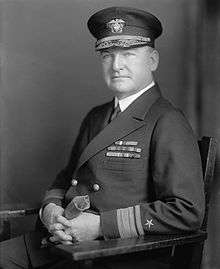 |
3 June 1933 | 29 May 1934 | Fulfilled Sims′s unrealized goal of establishing the Advanced Course for officers who had completed the senior course; taught by prominent educators rather than college staff, the Advanced Course studied matters of "international relations, major strategy, and the broader aspects of warfare, with particular attention to German and Japanese aspirations."[31] Secured funding for the construction of Pringle Hall, which opened in 1934 and served as the college′s wargaming center until 1957.[32] |
| – | – | – | – | 29 May 1934 | 18 June 1934 | Captain H. D. Cooke served as acting president between the departure of McNamee and the arrival of Kalbfus. |
| 22 | Rear Admiral | Edward C. Kalbfus |  |
18 June 1934 | 15 December 1936 | First of two terms as college president. Staunch advocate of the college's value to the U.S. Navy. Exhibited great effort during both this term and his 1939–1942 term to further the college's objectives in the Navy and to increase its stature locally in the City of Newport, Rhode Island. Revised and expanded the college pamphlet Estimate of the Situation to create the textbook Sound Military Decision, which superseded the pamphlet.[33] |
| – | – | – | – | 15 December 1936 | 2 January 1937 | Captain H. D. Cooke served as acting president between the departure of Kalbfus and the arrival of Snyder. |
| 23 | Rear Admiral | Charles Philip Snyder | 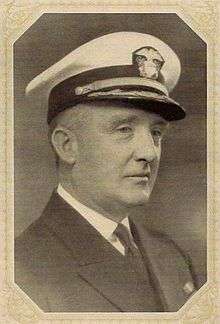 |
2 January 1937 | 27 May 1939 | Revised Sound Military Decision and issued his own version in May 1938.[34] Started subscription campaign to fund a portrait of Alfred Thayer Mahan for Mahan Hall.[35] |
| – | – | – | – | 27 May 1939 | 30 June 1939 | Captain John W. Wilcox, Jr. served as acting president between the departure of Snyder and the arrival of Kalbfus. |
| 24 | Admiral | Edward C. Kalbfus |  |
30 June 1939 | 2 November 1942 | Second of two terms as college president; he returned to complete his work on Sound Military Decision. Continued the advocacy for the college he had displayed in his first term and oversaw the college's 1942 production of Sound Military Decision as the U.S. Navy's only published guide to naval planning.[34] Succeeded in convincing the Navy to keep the college open during World War II. Successfully completed subscription campaign to fund a portrait of Alfred Thayer Mahan for Mahan Hall by appealing to living college graduates to contribute US$1.00 each.[35] served as a rear admiral until 16 June 1942, then as a retired admiral.[36] |
| 25 | Vice Admiral | William S. Pye | 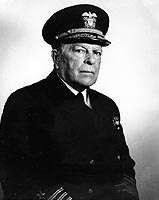 |
2 November 1942 | 1 March 1946 | Served as Naval War College President during the World War II years. During his tenure, the college conducted abbreviated courses that trained officers in the practical requirements for duty on a staff or in command while serving at sea or with the shore establishment. In March 1944, United States Secretary of the Navy Frank Knox appointed Pye to head a board of officers – usually referred to as the "Pye Board" – to study naval professional military education; it recommended, among other things, that the Navy establish three levels of officer education at the college and vastly increase the number of officers attending the college. The Navy approved little of what the Pye Board recommended, but a subsequent board headed by Rear Admiral James L. Holloway, Jr., took into account the work of the Pye Board. Pye retired as a rear admiral on 1 July 1944, but was immediately recalled to active duty to continue as president and was promoted to vice admiral. After the conclusion of World War II in August 1945, Pye prepared the college to reopen with its normal curriculum and schedule. He retired on 1 March 1946, his last day as college president.[37] |
| 26 | Admiral | Raymond A. Spruance | 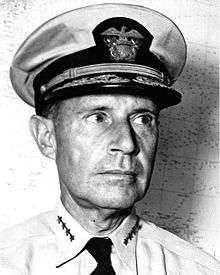 |
1 March 1946 | 1 July 1948 | Lent dignity and prestige to the college as it led preparations for Cold War-era naval education; expanded the curriculum; established academic chairs for a distinguished civilian historian and a political scientist; laid the groundwork for what would become the Naval War College Review |
| – | – | – | – | 1 July 1948 | 1 November 1948 | Rear Admiral Allen Edward Smith served as acting president between the departure of Spruance and the arrival of Beary. |
| 27 | Vice Admiral | Donald B. Beary | 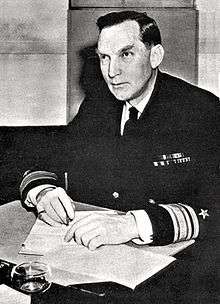 |
1 November 1948 | 28 May 1950 | Sought to broaden the views of students by bringing business authorities and leaders to meet with them in roundtable discussions, laying the groundwork for the college's Global Strategy Discussions of the 1950s and Current Strategy Forum of today. |
| – | – | – | – | 28 May 1950 | 1 December 1950 | The college had two acting presidents – Rear Admiral Thomas R. Cooley from 28 May 1950 to 17 October 1950 and Captain Harry D. Felt from 17 October 1950 to 1 December 1950 – between the departure of Beary and the arrival of Conolly. |
| 28 | Vice Admiral | Richard L. Conolly | 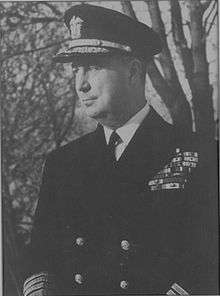 |
1 December 1950 | 2 November 1953 | Made major reforms to allow the college to build on the insights gained during World War II, and restored the civilian academic chairs of history and political science originally created by Spruance. |
| – | – | – | – | 2 November 1953 | 3 May 1954 | Rear Admiral Thomas H. Robbins served as acting president between the departure of Conolly and the arrival of McCormick. |
| 29 | Vice Admiral | Lynde D. McCormick | 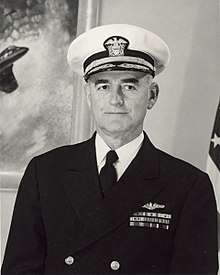 |
3 May 1954 | 16 August 1956 | Established a new course for senior officers of foreign navies, the predecessor of today's Naval Command College, but died before it could begin, the first Naval War College president to die in office. |
| – | – | – | – | 16 August 1956 | 5 September 1956 | Rear Admiral Thomas H. Robbins served as acting president between the death of McCormick and his own assumption of the presidency as McCormick's successor. |
| 30 | Rear Admiral | Thomas H. Robbins, Jr. | 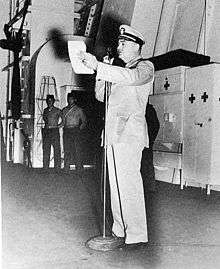 |
5 September 1956 | 1 August 1957 | Instituted the senior foreign officer course created by his deceased predecessor McCormick |
| 31 | Vice Admiral | Stuart H. Ingersoll |  |
13 August 1957 | 30 June 1960 | Brought a broad background in post-World War II planning and leadership in unified commands to the college; oversaw the changeover of the college's wargaming from manual to computerized processes. Served on the Civil War Centennial Commission while at the college, beginning in autumn 1957.[38] |
| 32 | Vice Admiral | Bernard L. Austin |  |
30 June 1960 | 31 July 1964 | Four-year presidency was the longest in the college's history at the time; played a key role in creating the Naval Command College for senior foreign naval officers; served in 1963 as president of a board of inquiry looking into the loss of the submarine USS Thresher (SSN-593).[39] |
| 33 | Vice Admiral | Charles L. Melson | 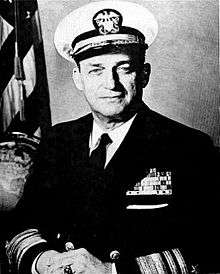 |
31 July 1964 | 25 January 1966 | Supported a greater emphasis on basic naval subjects; expanded the use of the Naval Electronic Warfare Simulator (NEWS) in the college's wargaming; oversaw the construction of an addition to Mahan Hall for an expanded library collection |
| – | – | – | – | 25 January 1966 | 15 February 1966 | Rear Admiral Francis D. Nuessle served as acting president between the departure of Melson and the arrival of Hayward. |
| 34 | Vice Admiral | John T. Hayward | 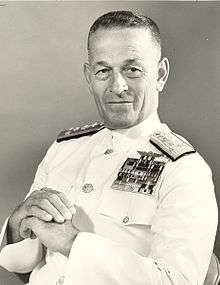 |
15 February 1966 | 30 August 1968 | Introduced a program to realign the college's curriculum along the lines of civilian colleges; began a program for appropriate physical facilities that would lead to the construction of Spruance Hall, Conolly Hall, and Hewitt Hall during the 1970s |
| 35 | Vice Admiral | Richard G. Colbert | 30 August 1968 | 17 August 1971 | Consolidated and strengthened the curriculum established by his predecessor; set in motion the construction of Spruance, Conolly, and Hewitt Halls; laid the groundwork for a Naval Staff College course for intermediate-level foreign officers; established the Naval War College Foundation; instituted the International Seapower Symposia, a biennial international meeting of the chiefs of navies | |
| 36 | Vice Admiral | Benedict J. Semmes, Jr. | 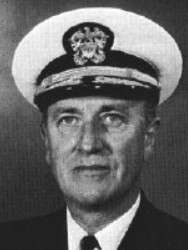 |
17 August 1971 | 30 June 1972 | Shifted the college's emphasis from foreign and international affairs to management concepts |
| 37 | Vice Admiral | Stansfield Turner | 30 June 1972 | 9 August 1974 | Charged by Chief of Naval Operations Admiral Elmo Zumwalt to change the college radically by establishing a rigorous and challenging curriculum which would give military officers understanding outside their own narrow specialities and improve their ability to analyze problems effectively; created the three-course curriculum still in use at the college; required the analysis of historical case studies; established a full-time teaching and research faculty with credentials from the best universities | |
| 38 | Vice Admiral | Julien J. LeBourgeois | 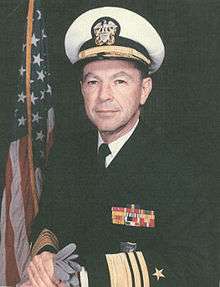 |
9 August 1974 | 1 April 1977 | Consolidated and refined his predecessor's radical curriculum changes; laid the groundwork for the creation of the Center for Advanced Research; initiated the establishment of a museum of naval history and the U.S. Navy's regional history in Founders Hall |
| 39 | Rear Admiral | Huntington Hardisty | 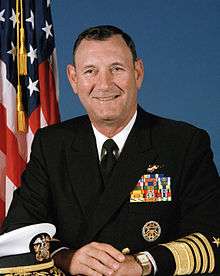 |
1 April 1977 | 13 October 1977 | During his six-month presidency – the shortest in the college's history – he worked conscientiously to carry out the academic programs his predecessor had initiated |
| 40 | Vice Admiral | James B. Stockdale |  |
13 October 1977 | 22 August 1979 | Expanded the college's elective course offerings, including courses unrelated to naval warfare; taught a course on military ethics inspired by his own experience as a prisoner-of-war during the Vietnam War |
| 41 | Rear Admiral | Edward F. Welch, Jr. | 22 August 1979 | 17 August 1982 | Emphasized fleet operations in the college's curriculum and wargaming; instituted the Global Wargame; established a program under which naval officer students could earn master's degrees working with other colleges and universities in the area | |
| – | – | – | – | 17 August 1982 | 14 October 1982 | Captain David Self served as acting president between the departure of Welch and the arrival of Service. |
| 42 | Vice Admiral | James E. Service | 14 October 1982 | 12 July 1985 | Presided over the college's centennial, the opening of an enlarged museum in Founders Hall after a two-year renovation, and the publication of Sailors and Scholars, a history of the college's first 100 years | |
| – | – | – | – | 12 July 1985 | 8 August 1985 | Captain Robert Watts served as acting president between the departure of Service and the arrival of Marryott. |
| 43 | Rear Admiral | Ronald F. Marryott | 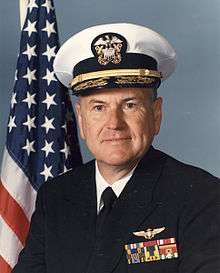 |
8 August 1985 | 12 August 1986 | Promoted the college's role in developing strategic ideas and refining concepts |
| – | – | – | – | 12 August 1986 | 2 September 1986 | Captain Robert Watts served as acting president between the departure of Marryott and the arrival of Baldwin. |
| 44 | Rear Admiral | John A. Baldwin, Jr. | .jpg) |
2 September 1986 | 11 August 1987 | Initiated the process for accreditation of the college to grant master's degrees, which it would receive in 1991; established the Institute for Strategic Studies to facilitate accreditation and retain talented faculty; and restored the college library after a fire inflicted serious damage on it. |
| 45 | Rear Admiral | Ronald J. Kurth | 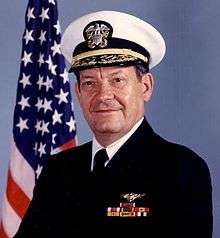 |
11 August 1987 | 17 July 1990 | Testified before the United States Congress about the effect on military education of the Goldwater-Nichols Act; conceived the idea that would lead to the accreditation of the college to grant master's degrees; began the long-term effort to construct a new building |
| 46 | Rear Admiral | Joseph C. Strasser | 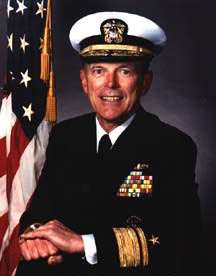 |
17 July 1990 | 29 June 1995 | The longest-serving president of the college, serving for five years; oversaw the college's transition from the Cold War era as the Warsaw Pact and Soviet Union collapsed; achieved accreditation of the college by the New England Association of Schools and Colleges to grant a Master's degree in National Security and Strategic Studies; acquired Congressional approval for the construction of the Strategic Maritime Research Center, McCarty-Little Hall; inaugurated combined Russia-United Kingdom-United States (RUKUS) wargames |
| 47 | Rear Admiral | James R. Stark | 29 June 1995 | 24 July 1998 | Reorganized the curriculum of the College of Continuing Education to allow officers to complete the course in a single shore tour; oversaw the construction of McCarty-Little Hall; began planning for a new library and administration building; incorporated the Naval Warfare Development Center into the college's operations | |
| 48 | Vice Admiral | Arthur K. Cebrowski | 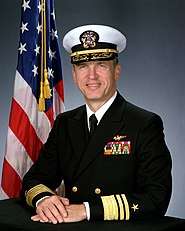 |
24 July 1998 | 22 August 2001 | Introduced network-centric warfare into the college's curriculum and research and Information Age warfighting concepts into its wargaming; introduced "transformation" to the college so that the college could serve as an agent of change for Navy leadership grappling with rapid changes in warfare; shifted the college's geographic focus of study to Asia and the Pacific Ocean |
| 49 | Rear Admiral | Rodney P. Rempt | _Rodney_P._Rempt.jpg) |
22 August 2001 | 9 July 2003 | Refocused the college's efforts against threats made apparent by the terrorist attacks of 11 September 2001; initiated homeland security games involving local, state, and United States Government agencies; raised the college's prominence and increased the number of students in its various programs; conducted a wide-ranging review of U.S. Navy graduate and professional education policy that resulted in many changes; oversaw the college's production of a series of influential point papers for the senior leadership of the United States and the United States Armed Forces |
| 50 | Rear Admiral | Ronald A. Route | 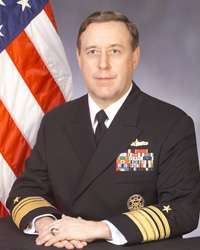 |
9 July 2003 | 12 August 2004 | Sharpened the college's focus on mission and relevance; initiated research, analysis, and wargaming to address key operational concerns of the U.S. Navy such as ballistic missile defense and antisubmarine warfare and established the Halsey Scholars, an advanced research program for selected students; facilitated discussions between retired Soviet Navy officers and their American counterparts on Cold War naval history |
| 51 | Rear Admiral | Jacob L. Shuford | 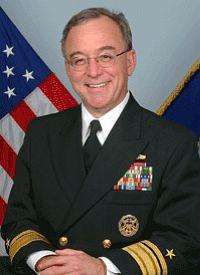 |
12 August 2004 | 6 November 2008 | Directed extensive restructuring of the basic curriculum; initiated the Joint Force Maritime Component Commander Course for flag officers, the Maritime Staff Operators Course, and the Operational Planner Course; led the college as it played the key role in designing the process for establishing a new national maritime strategy and in providing the geostrategic analysis to support it; reinstituted Title 10 wargaming; initiated concept-development efforts to explore important warfare issues such as maritime ballistic missile defense, antisubmarine warfare, homeland defense organization, and the command and control of maritime forces; engaged in extensive diplomacy to establish an international network of naval colleges that could collaborate on the study of maritime security issues |
| 52 | Rear Admiral | James P. "Phil" Wisecup |  |
6 November 2008 | 30 March 2011 | Inaugurated the Chinese-language library for the China Maritime Studies Institute, hosted the Current Strategy Fora, co-hosted the Nineteenth International Seapower Symposium – the largest gathering of naval leadership in world history – and oversaw the College's 125th anniversary commemoration.[3] |
| 53 | Rear Admiral | John N. Christenson |  |
30 March 2011 | 2 July 2013 | Stimulated War College innovation, broke new ground in Navy leader education, expanded international outreach, and increased support to fleet operational-level training through his promotion of faculty research and war-gaming. During his tenure, the College provided hands-on assistance to fleet staffs in venues such as the Fleet Synchronization Conference, Current Strategy Forum, Leader Development Strategy, and the International Seapower Symposium.[40] |
| 54 | Rear Admiral | Walter E. Carter Jr. |  |
2 July 2013 | 8 July 2014 | First Naval Flight Officer to lead the Naval War College. Led the college during an unprecedented period of fleet interaction and international engagement. Led the efforts to establish the Advanced Studies in Naval Strategy Program at the college to create a cadre of U.S. Navy strategists. Designated by the Chief of Naval Operations to oversee all leadership and ethics training throughout the U.S. Navy, his white paper "Ethics in the Navy" was a watershed publication that became the cornerstone for ethical discussions within the U.S. Navy and the joint force. During his tenure he established the Navy Leadership and Ethics Center.[41][40] |
| 55 | Rear Admiral | P. Gardner Howe, III |  |
8 July 2014 | 25 July 2016 | First Navy SEAL to lead the Naval War College[41] Focused the college on preparing leaders for the challenges of an increasingly complex operational environment and the rise of near-peer competitors, including the reinvigoration of a sense of the Navy as a profession and leading the Navy's initiatives to improve leader development.[40] |
| 56 | Rear Admiral | Jeffrey A. Harley | .jpg) |
25 July 2016[42] | 10 June 2019[43] | Earned degrees from the University of Minnesota and the Fletcher School of Law and Diplomacy in addition to the Naval War College.[42] Told the press that the college was under fiscal strain because of the U.S. Navy′s failure to fund its new missions.[44] Told faculty and staff that the college was granting pay raises to some employees and increasing payments to some contractors and others to remedy pay gaps between men and women, balance the income of employees in different departments, and create a pay system that would avoid future disparities, and declared that the college would have to engage in across-the-board cuts; including in travel budgets, in order to make payroll.[44] Reassigned by the Chief of Naval Operations, Admiral John M. Richardson, while under investigation following an April 2018 allegation by Naval War College personnel that he abused his hiring authority and engaged in excessive spending and other inappropriate behavior, such as using a margarita machine in his office.[43] The first president removed from office. |
| – | – | – | – | 10 June 2019 | 1 August 2019 | Provost Lewis Duncan served as acting president between the departure of Harley and the arrival of Chatfield.[43][45] |
| 57 | Rear Admiral | Shoshana S. Chatfield | .jpg) |
1 August 2019 | First woman to serve as Naval War College president.[45] |
Notes
- President's Report Spring 2010. Naval War College: Newport, Rhode Island. 2010. p. i. ISBN 978-1-884733-78-9. Retrieved 30 July 2013.
- "Past Presidents". Naval War College. Archived from the original on 27 June 2007. Retrieved 30 July 2013.
- Pentangelo, John, and Joshua Howard, "Artifact Spotlight: Portrait of Rear Admiral James P. Wisecup, 2010," Soundings in Narragansett Bay's Naval History: The Naval War College Museum Blog, March 31, 2011
- For the first 51 presidents, this table is based on information at the "Past Presidents" page at the Naval War College Web site. Archived 8 November 2010 at WebCite For the 52nd and 53rd presidents, the list is derived from information at the President's House Occupants page on the Naval War College Web site. Information on acting presidents is from the Naval War College Illustrated History and Guide, pp. 14–15. Additional information from other sources is footnoted separately.
- Hattendorf, Simpson, and Wadleigh, pp. 34–35.
- Hattendorf, Simpson, and Wadleigh, pp. 52–53.
- Hattendorf, Simpson, and Wadleigh, p. 53.
- Hattendorf, Simpson, and Wadleigh, pp. 56–57.
- Hattendorf, Simpson, and Wadleigh, p. 56.
- Hattendorf, Simpson, and Wadleigh, p. 55.
- Hattendorf, Simpson, and Wadleigh, p. 325.
- "Chronology of Courses and Significant Events 1900-1909". U.S. Naval War College. Retrieved 30 July 2013.
- Hattendorf, Simpson, and Wadleigh, pp. 62–63.
- Miller, Edward S. War Plan Orange: The U.S. Strategy to Defeat Japan, 1897-1945. Annapolis, Maryland: Naval Institute Press, 1991. ISBN 0-87021-759-3., p. 16.
- Hattendorf, Simpson, and Wadleigh, p. 155.
- Hattendorf, Simpson, and Wadleigh, pp. 75–76.
- Miller, Edward S. War Plan Orange: The U.S. Strategy to Defeat Japan, 1897–1945. Annapolis, Maryland: Naval Institute Press, 1991. ISBN 0-87021-759-3., pp. 24, 46, 70, 80-81.
- Hattendorf, Simpson, and Wadleigh, p. 79.
- Hattendorf, Simpson, and Wadleigh, p. 80.
- Hattendorf, Simpson, and Wadleigh, p. 81.
- Hattendorf, Simpson, and Wadleigh, pp. 57, 67.
- Doenecke, Justus D., Nothing Less Than War: A New History of America′s Entry Into World War I, The University Press of Kentucky, 2011, p. 154.
- Naval History and Heritage Command: Letter from Rear Admiral Austin M. Knight, President, Board Of Awards, To Senator Frederick Hale Of Maine, Chairman Of The Subcommittee Of The Committee On Naval Affairs, June 10, 1920.
- Hudson Maxim, Defenseless America, New York: Hearst’s International Library Co., 1915, p. 152.
- Hearings Before Committee on Naval Affairs of the House of Representatives on Estimates Submitted by the Secretary of the Navy, Washington, DC: Government Printing Office, 1915, pp. 676-7
- International Law Topics: Documents on Neutrality and War with Notes, 1915 Washington, D.C., 1916, p. 3.
- Hattendorf, Simpson, and Wadleigh, p. 129.
- Hattendorf, Simpson, and Wadleigh, p. 141.
- Hattendorf, Simpson, and Wadleigh, pp. 143–144.
- Hattendorf, Simpson, and Wadleigh, p. 142.
- Hattendorf, Simpson, and Wadleigh, pp. 146–148.
- Hattendorf, Simpson, and Wadleigh, p. 149.
- Hattendorf, Simpson, and Wadleigh, pp. 157–159.
- Hattendorf, Simpson, and Wadleigh, p. 159.
- Hattendorf, Simpson, and Wadleigh, p. 149.
- Naval War College Illustrated History and Guide, p. 15.
- Hattendorf, John B., B. Mitchell Simpson, III and John R. Wadleigh. Sailors and Scholars: The Centennial History of the U.S. Naval War College. Newport, Rhode Island: Naval War College Press, 1984
- Cook, Robert. J., Troubled Commemoration: The American Civil War Centennial, 1961–1965, Baton Rouge, Louisiana: Louisiana State University Press, 2007. ISBN 978-0-8071-3227-2, pp. 31, 138.
- "A Register of His Papers in the Naval Historical Foundation Collection in the Library of Congress: Manuscript Division, Library of Congress, 2008. p. 4" (PDF). Retrieved 30 July 2013.
- usnwc.edu Past Naval War College Presidents

- Church, Lindsay (8 July 2014). "First SEAL Takes Helm as Naval War College President". U.S. Naval War College Public Affairs. Retrieved 27 July 2014.
- Elliot, Ezra J. (25 July 2016). "New president takes helm at U.S. Naval War College". U.S. Naval War College Public Affairs. Retrieved 19 November 2016.
- McDermott, Jennifer (12 June 2019). "CNO Richardson: Removal of Naval War College president warranted". Navy Times. Retrieved 4 August 2019.
- McDermott and Michelle R. Smith, Jennifer (11 June 2019). "Naval War College head reassigned pending probe". Associated Press. Retrieved 30 December 2019.
- "Naval War College's 1st female president takes command". Navy Times. 2 August 2019. Retrieved 4 August 2019.
References
- Hattendorf, John B., B. Mitchell Simpson, III and John R. Wadleigh. Sailors and Scholars: The Centennial History of the U.S. Naval War College. Newport, Rhode Island: Naval War College Press, 1984.
- Jackson, John E., Jondavid Duvall, and Kimberly Rhoades, eds. Naval War College Illustrated History and Guide, Second Edition. Washington, D.C.: Government Printing Office, 2010. ISBN 978-1-884733-72-7, ISBN 1-884733-72-7.
External links
- Past Presidents page at the Naval War College official website
- President's House Occupants at the Naval War College official website